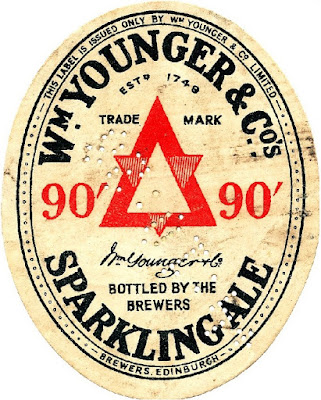If you just look at the pitching temperatures, you could be forgiven for thinking Scottish beer was fermented cooler than English. A look at full fermentation records soon put me straight. Many Scottish beers were pitched a few degrees cooler than the English norm of around 60 F.
There’s a simple explanation: a higher percentage of very strong beers were made in Scotland. The higher the gravity, the lower the pitching temperature to accommodate the extra heat generated during fermentation. The maximum fermentation temperatures in England and Scotland were roughly similar.
The other claim is that primary fermentation was much longer in Scotland than in England, because of the low temperature it was carried out at. To put it bluntly, this is total bollocks. Most Scottish brewing records contain a full fermentation record making it easy to check. Scottish beer took no longer to ferment than English.
The William Younger brewing logs have columns charmingly entitled “Heats and Beats in Guile”. They record the progress of the fermentation and when the wort was roused to encourage fermentation. Here’s an example:
| William Younger Shilling Ale fermentations in 1848 | ||||||||
| Heats and Beats in Guile | ||||||||
| Beer | OG | day 1 | day 2 | day 3 | day 4 | day 5 | day 6 | day 7 |
| Table | 1035 | 59º F | 60º F | 62º F | 64º F | |||
| 42/- | 1043 | 59º F | 61º F | 63º F | 66º F | |||
| 60/- | 1064 | 58º F | 59º F | 62º F | 65º F | |||
| 80/- | 1074 | 58º F | 59º F | 62º F | 64º F | 66º F | 67º F | |
| 100/- | 1086 | 57º F | 58º F | 60º F | 63º F | 66º F | 68º F | 68º F |
| 120/- | 1103 | 54º F | 56º F | 59º F | 62º F | 66º F | 69º F | 70º F |
| 140/- | 1115 | 54º F | 58º F | 62º F | 66º F | 70º F | 72º F | |
| Source: | ||||||||
| William Younger brewing record held at the Scottish Brewing Archive, document number WY/6/1/2/3. | ||||||||
Fermented almost as cold as Lager? I think not. Seven days primary fermentation for a beer with an OG of over 1100º is by no means excessive.
I’ll admit that this totally contradicts what W.H. Roberts wrote about Scottish fermentation temperatures:
". . while the English brewers frequently set their worts as high as 75º, or, according to some practical writers, occasionally 80º, the Scottish seldom if ever exceed 58º, and, in some cases, fall so low as 44º.
. . . it is not uncommon for Scottish brewers to have their gyles in the tun for twenty-one days, whilst in England, so long a period as even six days is considered as of rare occurrence."
"Scottish Ale Brewer" by W.H. Roberts, 1847, page 108.
It’s a contemporary account, written by someone with practical experience of brewing. But, In this case, I have to go with the William Younger’s brewing records. They show temperatures well above 58º F and nothing anywhere near as low as 44º F. I’ve never seen a Scottish fermentation that was longer than 7 days. It’s hard to reconcile with Roberts’ description. Perhaps he was talking about older practices that had been superseded.
The above is an excerpt from my excellent book on Scottish brewing:
http://www.lulu.com/shop/ronald-pattinson/scotland-vol-2/paperback/product-23090497.html












































































3 comments:
And this tripe gets passed around as fact by well meaning but ignorant of the facts members of every homebrew forum in existence. It is second only to the cringeworthy peat smoked malt fairytale.
Slightly off topic but is it the case that Yorkshire Stone Square fermentation was at a lower temperature than Burton and Southern ales?
When using something like Wyeast 1469 West Yorkshire Ale, I always set the controller to 17 degrees C.
I grew up in Scotland and the first winter I spent in Bavaria, I had never been so cold in my life. The climates are not remotely similar.
Post a Comment